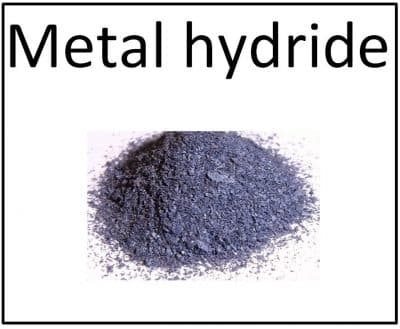
The unit producing hydrogen and power in this scenario is a high-temperature rSOC, or reversible Solid Oxide Cell, and the material used for hydrogen storage consists of high-temperature metal hydrides. The latter can store both hydrogen and thermal energy, leading to the above-mentioned efficiency improvements.
Combined hydrogen and heat storage
Many metals and alloys, such as magnesium or iron-titanium (FeTi), react with hydrogen to form so-called metal hydrides, where the hydrogen has been chemically bonded to the metal lattice based on the following formula [1]:
This process is reversible. To release the hydrogen, one would theoretically have to use the same amount of heat as during storage. The process of storing and reconverting hydrogen could simultaneously be utilized for storing and releasing heat. Compared to conventional pressure vessels, metal hydride storage systems have a more than 10 times higher energy density by volume at pressures of 30 to 50 bars – and sometimes even far below those values. For example, they have five to 10 times the heat capacity of molten salt storage systems at temperatures between ambient and 1,000 °C (e.g., MgH2/Mg: 2,885 kJ/kg or 1,362 kWh/m3 at a bit more than 300 °C). When hydrogen is stored in the form of a chemical bond, as is the case with metal hydrides, there is no self-discharge (when bonded) or heat loss (when separated) – both for hydrogen and heat.
…
Pinch analysis of rSOC metal hydride storage
Water electrolysis requires a minimum energy amount of 285.7 kJ per mole of H2. In low-temperature electrolysis (e.g., PEM or alkaline electrolyzers), much of the demand is met by electrical sources. Conversely, high-pressure steam electrolysis in an SOEC will make it possible to provide part of the energy – for the enthalpy of vaporization and the increase to rSOC operating temperature – not by electric, but thermal means.
Another source of waste heat besides the rSOC’s ohmic heating (not considered) is the heat of reaction when hydrogen is absorbed (to form metal hydride). If the waste heat provided can be used for vaporization (see also fig. 3), the calorific value of the hydrogen produced in steam electrolysis (285.7 kJ per mole of H2) will exceed the electrical energy required at 850° C (around 250 kJ per mole of H2) and electrical efficiency alone will be pushed above 100 percent.
…
Total storage efficiency
The waste heat from the metal hydride reaction was selected to match the heat demand of electrolysis (ideal scenario). In this simplified model, 65 percent of the stored heat can later be provided in the form of electrical energy. Energy can be stored in the metal hydride indefinitely and long-time storage will not decrease efficiency, as the hydrogen is part of a stable chemical bond.
…
This model does not consider losses incurred during real-world operation due to power consumption by the system (blower to supply air, etc.), heat release into the ambient air or heating/cooling required for changing the operation mode.
In addition to these inevitable losses, the storage efficiency of electrical energy mainly hinges on the heat amount produced by the metal hydride reaction ΔHR;MH and the current density in SOFC operation (variable “i”; see fig. 4).
Metal hydride storage materials
The best materials to use for the above-described system are metal hydrides with an enthalpy of reaction as close as possible to 48 kJ per mole of H2 (see fig. 4), as they can meet the heat demand of electrolysis. Binding hydrogen with metal hydrides needs to be possible at temperatures at which the feedwater can be turned into vapor even if pressure is added. The metal hydride should also possess a good enough reaction rate even at very small absorption pressures to save energy during compression. When the fuel cells are in operation, the rSOC delivers heat at 650 to 850 °C. Discharging the metal hydride should already be possible below this temperature range.
…
Magnesium hydride could indeed be an option of great interest, as it is relatively inexpensive. However, the heat of reaction is above 70 kJ per mole of H2, greatly exceeding the net heat demand of the SOEC and making it less than ideally suited to achieve high efficiencies (see fig. 5). And during dehydrogenation, the SOFC would need to match the high specific heat, which limits its maximum electrical efficiency. A high-temperature alloy composite based on lithium borohydride and magnesium hydride (operating temperatures of 300–450 °C) is out of the question due to its high price.
Conversely, sodium aluminum hydride, a material with an operating temperature of between 120 and 180 °C (see fig. 5 and description in [2]) will have one expect storage material costs to be around as low as for magnesium hydride. Another point in its favor is a low reaction temperature (120 to 160 °C), meaning the reactor does not require any heat-resistant steel. All in all, it seems to be the most promising solution to date.
Summary and outlook
Considering the energy balance of a power-to-power system based on rSOC-technology, the use of metal hydride storage systems has its advantages over conventional pressure vessels at the same capacity levels if the aim is high electrical efficiency. Thermal integration using the waste heat of the system, as described in this article, offers the opportunity to increase the efficiency of electrical energy stored in it to 65 percent. Such systems would only …
The findings presented in this report were taken from Anselm Strauch’s master’s thesis funded jointly by Sunfire GmbH and Helmholtz-Zentrum Geesthacht.
Authors: Anselm Strauch, Norderstedt, Dr. Klaus Taube, Helmholtz-Zentrum Geesthacht GmbH, Dr. Oliver Posdziech, sunfire GmbH, Dresden


























Thank you for a very informative article on this fascinating subject.
It appears that McPhy’s system is primarily based on a magnesium hydride process developed in collaboration with the French National council for Scientific Research (Conseil national de recherche scientifique – CNRS). They also seem to have expressed interest in developing SOEC markets/use that would leverage this technology. Another company involved in this tech is Belgian Solvay.
Would anyone know if there are other major PAC manufacturers involved in industrial applications of this technology?